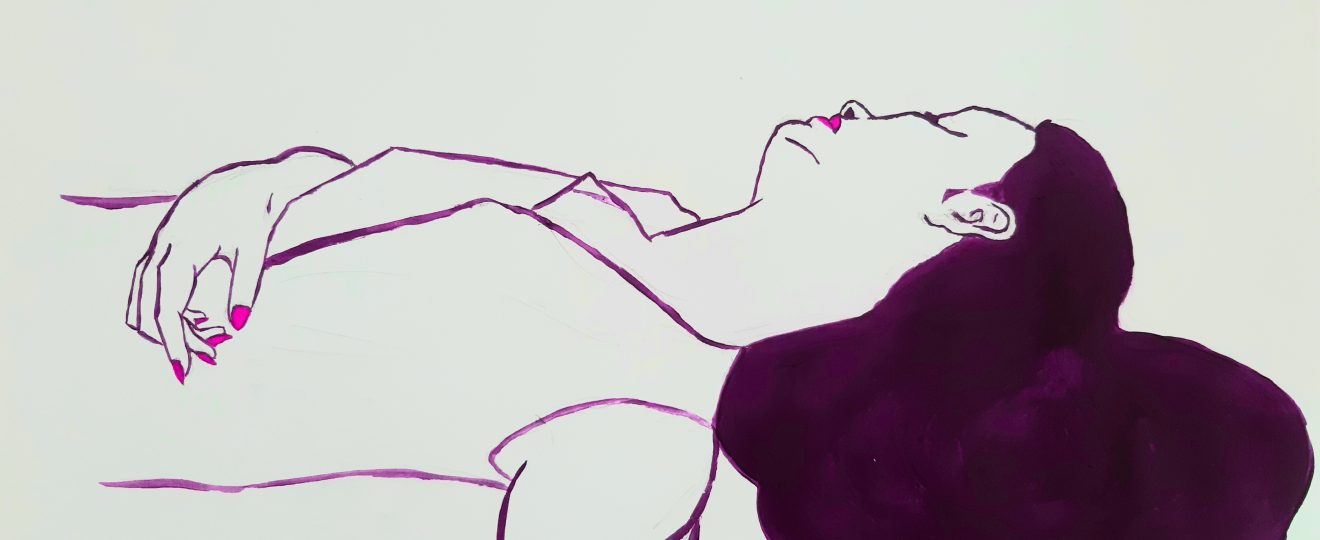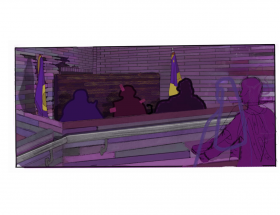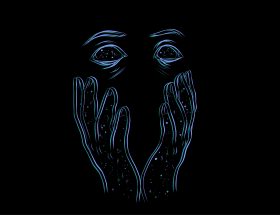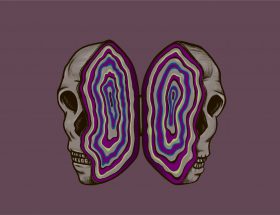Recently, I have become slightly obsessed with reading about Jane Does. Did you know, there is a list, on Wikipedia, of every unidentified murder victim in the United States? Unidentified decedents too, those who haven’t died of any discernible homicidal cause-it has some overlap with the murder list, but, perverse as it is, it isn’t quite as exciting to read. California, Florida, Pennsylvania, New York, and Texas all have their own, separate articles, as the number of Jane and John Does who are still unknown there is too large to fit in the overall page. There’s probably a list for Britain too, and France, and Zimbabwe and Sweden, but the list for America seems more right, for some reason. All those people, brushing tangentially past one another in the fluorescent shops, on the beach-side pavements, never knowing each other at all. All those lonely open plains.
Did you also know, in Texas, there’s an area adjacent to the Calder Oil Field, a mile from the I-45 interstate, called the Killing Fields? I do. From the pictures I found on Google, you can see the black husks of the oil refineries, pocking the distance, filled with men whose muscles are ropey and have daughters of their own and the omnipresent dust of fossil fuel detritus that hangs about every coal or oil or gas worker lined into their eyes and their mouths. (Being Welsh, I know this; you can still tell, if you go for a day trip to the Valleys, which of the old men that hang about with their folded Daily Mirrors and wan, grey dai caps outside the SPAR were coal miners, and which weren’t, because of that same dust. Port Talbot Steel Works is the same, haunted men and women smiling and still looking like shadows with that powder in the lines of their face. What is it? Who knows. Even the colour is an ephemeral grey-green-black, a can’t-put-your-finger-on-it colour. The colour of pigeons and Filco bags and Victorian birthing chairs. But it is there, no matter your chosen disintegrated ventricle/marrow/palm-frond mixed bucket of dinosaur parts poison, whether particularised, sludgey or hardened into unhappy lumps. The people who own the companies, however, never seem to have it. Funny, that.). Hard-drinking, hard-working people, who, like Springsteen’s River, got married young and drag themselves from a warm (perhaps too warm-Texas is hot, right?) bed every morning in order to toil in a choking, hot, dirty room to bring home Mac’N’Cheese for their kids and put money into pay-monthly schemes for Christmas presents.
To the other side, you can see the I-45, just in the distance, just enough to run it if you were really fast. You can see the glints of cars, coming to and from Texas City. Tourist cars, shiny green and rust red. Wafts of hot oil and McDonald’s (there’s a new Drive-Thru a few miles back from it). Happy children singing along to trash-pop. Parents necking triple-shot coffee to get them through those last few miles. Older women, in their late 50s, ex-soccer moms and spinsters with warm smiles, who have been through the glut of male attention long enough to tell a young woman what to do when she receives it, and to offer her a safe trip home inside an old Ford that smells like cardigan wool and woven-in strands of NPR. While, of course, these refineries and cars will contain bad seeds, wife-beaters and child-fanciers and liars and cheats, perhaps the very bad seeds whose macabre predilections gave the Fields their name, but by and large? They are safe havens of other people, of protection. They are close enough to see, but not enough for them to hear you. Not enough for you to get there in time.
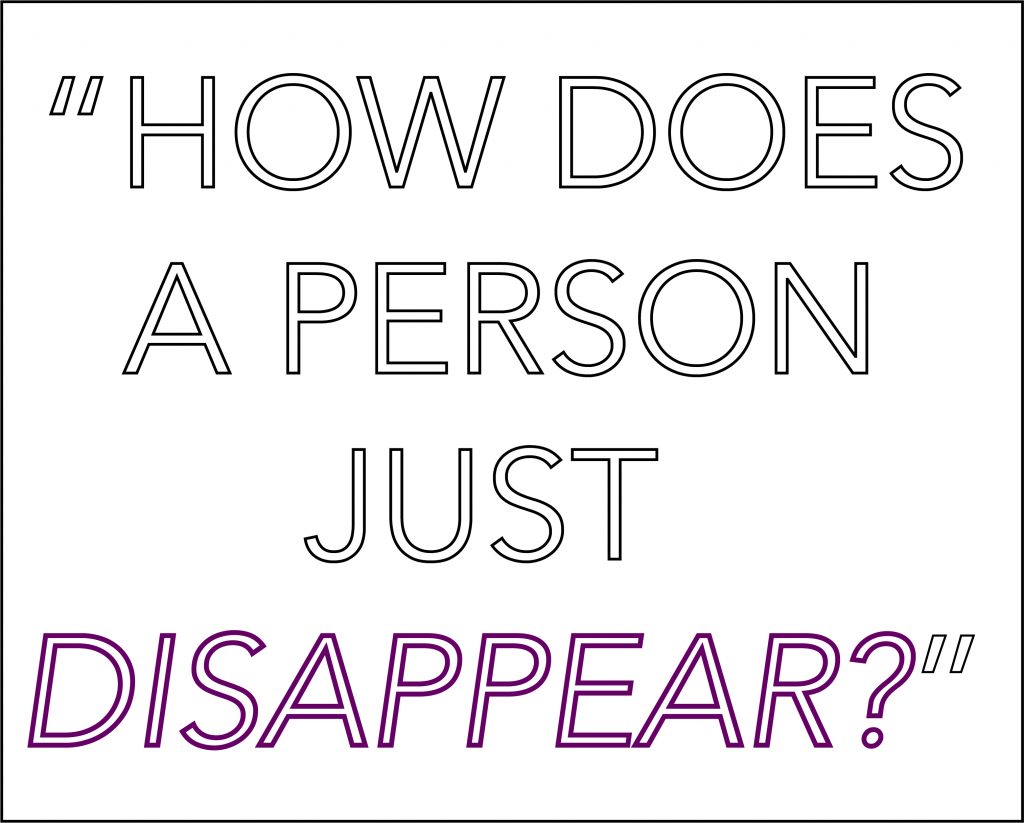
Since the early 1970s, over thirty bodies have been found in the Fields. They are greener than I expected, and tangly, with twigs and marsh-grass and the sort of woody holes an ankle can get stuck and twisted into. In my mind, Texas is all yellow sand and violet skies and open, howling coyotes. The Killing Fields are dank, and when you see the pictures, you can tell they smell like rot, organic matter, trash and piss. You just know they do. What a place to die. What a place for them to find your body. They were all women, the bodies, and the first one was found in 1971, the last in 2006. Different methods, different ages, different backgrounds, over such a long time-span, suggests different killers. Two men have definitely been convicted for different bodies found there, Kevin Edison Smith and Gerald Zweist, but conceivably all could have been murdered and tipped out by separate individuals. Some of them were in pairs, like Rhonda Johnson and Sharon Shaw (14 and 13, respectively). Others were alone. Others haven’t even been found, but were disappeared along the stretch, and law enforcers believe that they are still out there, waiting in the muck, eyes hollow and teeth rotten, ready to tell their stories (like Suzanne Richardson, who witnesses heard screaming in a hotel parking lot next to the Fields, and whose shoe was found the next day, lonely and foot-less. She hasn’t been seen or heard from since.)
The worst is, that some of these women were unidentified for years. Years, and years, and years. Donna Prudhomme (body found September 1991) and Audrey Cook (body found February 1986) were only given names in April 2019, after DNA tied them to other family. Before that, they were estimates, a collection of guesses about someone and something that once was. Biological guesses, at that; Audrey Cook was woman, 22 to 30 years old and 5-foot-5 to 5-foot-8. Died six weeks to six months prior to being found. Had a small caliber gunshot wound to the back. No hair colour, no eye colour, no clothes, no distinguishing marks. Not even a concrete age or height or death date. Donna Prudhomme was 24 to 34 years old, 5 feet to 5-foot-3 and weighed 100 to 130 pounds. Died six weeks to several months prior to being found. Several months! Not even a timescale. The most specific thing about her body they could glean was that it was left in the 3000 block of Calder Road. That is all that was left of them, them as people. When you look them up you can find a photo or two, now that they have been identified, but that’s about it. No remnants of their lives, or their memories.
There are lists and lists and lists of these people. Less now, after the invention of technology that tracks our movement, our money, our relationships, our photos. It is harder to not be found and not be recognised. Harder, but not impossible. The DNA Doe project has helped to identify twenty-three cases since its conception in 2017, including the infamous ‘orange socks’ girl, who became known for her footwear, and ‘buckskin girl’ who had a particularly snazzy poncho. The same has been achieved with WebSleuths, who match up pictures from missing person reports with reconstruction and sketches of Jane and John Does. Bizarrely, reading their finds is somehow more depressing than not knowing who they are at all. How many times did Debra Jackson’s mother or sister read, unknowingly, about her in a paper during the trial of Henry Lee Lucas? She was famous, for a Jane Doe. How many times did they scan her bare-bones, often intimate and insulting, description (insect bites, long dirty nails, unshaven legs, salpingitis due to untreated gonorrhoea, wearing a makeshift sanitary pad) with no semblance of recognition that it could be one of their own? Is that callousness, is that naivete-never thinking it could happen to you, your daughter, your friend-is that just sad? Did they remember her so alive that they could not even contemplate the idea that she might be dead? Did Marcia Sossoman King’s family ever drive through Ohio and hear about a body found and just wonder? She was born in Arkansas-did it seem inconceivable to them that she would not still be there, somewhere, alive? How many brushes with identification did their families have with their bodies? You would, at some level, resent the good people who provided you closure, wouldn’t you? For taking away the possibility, however slight, that they might be out there. Raising babies, taking drugs, drinking in the same summer day as you. And perhaps, you might resent them for what they say about you to the world; we managed to identify your daughter, your wife, your sister, before you did. How did you see the reconstructions and not think-it could be them? How did you not scour the death notices looking for them?
Sadder still are the identifications of people through far flung DNA matches, of a cousin’s cousin’s cousin who remembered vaguely that someone in the family went missing, but it wasn’t talked about, not really, and they never met them themselves. Mary Silvani’s story goes like this. On July 17th, 1982 in Sheep Flats, a buzzing hiking patch near Lake Tahoe, a group of neon-clad, gripped-trainers hikers found a body, face down and mouth dusty in the dirt. It was a woman. She had long, dark hair, redwood-hair, twisted up in a keep-cool bun to pull away strands from her face and her forehead where the sun would hit it and make it sweat. She wasn’t warm, but she wasn’t rotted either. She was young-old, the face of a life full of quiet happiness and quiet disappointment, and she could have been anywhere between twenty-five and forty. She wore light yellow trainers, the kind that helps you scramble up rocks and the kind that you can kick off easily to feel the sand and the lake water on your toes. She had a blue swimsuit under her jeans and sleeveless shirt. She’d been shot in the back of the head while she bent down to tie her shoes. Her aglets were the palest red with dried blood. She wasn’t identified for 39 years, until 2018, when a bleeding-heart scientist matched her, Mary Silvani, to a nephew, who didn’t know her, or even that his father had a sister. She was born in 1948 and so she was 33 when she died. She had two brothers, who were both dead by the time she was given back her name. Her mother had left her as a child, and her father died when she was sixteen. Her high school had a photo of her, but no record of her graduation. She had given up a child for adoption around 1972-her flat, tan stomach bore its mark with a curving, celestial-freckled Caesarean scar. They could not locate anyone who knew her.
Someone out there is Mary Silvani’s child, and they have no idea that their mother was brutally murdered on a sun-soaked hiking trail. No one had any idea at all. Mary Silvani ceased to exist in a second but spent 39 years nameless. What did she go there for, that day? Did she suck the clean, watery air through her teeth? Did she trip over a scraggly rock in the trail, and realise her laces had come undone? What was her last thought? Did she ever see the sky one last time, a flick of her eyes up as she threaded lace through lace?
That seems to really be the bitch about time, if you’ll excuse the expression. One minute Mary Silvani was a beating, breathing person, with thoughts and a favourite colour and a hunger that might have led her to buy a chocolate bar on the way home. And the next she became a body. A body with a vaccination hole in her upper left arm, and a marked belly, and yellow trainers and good dental work. And the next minute, and the next, and the next, until 39 years passed. A person became a physical remnant, made up only of the material things they left behind.
Do you ever leave the house thinking that maybe the clothes you’re wearing could be what marks your body out? Do you think Valentine Sally knew when she pulled over her red and white striped jumper on February 3rd, 1982 in an Arizona bedroom somewhere looking at the orange sand, that that sweater would be the thing she was remembered by? That and her uncompleted root canal. I think this, now. A lot of these girls, their forgotten, empty eyes left open to look at highways and rocks and the marshy bottoms of irrigation ditches, are not the girls you think would be the ones forgotten, as if there is a ‘correct’ missing person. They have good dental work, and nice clothes, good quality jewellery. Remnants of a life where a person would know them when they walked down the street, of a life where they had people to care for their teeth and their wrists and what they wore to school, a life where people would notice if they up and left, a life where those same people would recognise them, alive or dead. I think that I would be known, if I was killed. I don’t have any fillings, but I think the backs of my teeth might be identified from bulimia scars. I have two tattoos-the constellation of Draco, and Aphrodite’s shell-either side of my ribs. I don’t think I have any noticeable scars, but I have a faded white triangle under my bottom lip where I bit through it when I was little. It is an odd thing to think of yourself as an ‘unidentified decedent’. Female, between 18 and 25 (hopefully I don’t look older, and maybe they would think I was younger, but perhaps this is wishful thinking), 5’4-5’7. I don’t want to guess my weight. Brown hair, grey eyes. Freckles. I would think my mother would know me from these descriptions, but these women had distinctive features too. Peaches Doe and her cheeky, dripping-orange peach tattoo under her ribcage. Valentine Sally and her dodgy, inflamed tooth. Maybe they ended up too far from home, or maybe it is impossible to think of someone once alive as a body, even if that body has features you remember.
I try to take these girls with me, now. I think about them often, especially the ones around my age, my height, my circumstance-empathy is always easier with similarity. When we drive under a particularly brilliant sky, or I bite into a bright, crunchy apple, I think that they too would like its colours, the snap of pear-drop flesh between their teeth. But that, too, is further clouding their memory from view. I don’t know what they would have thought. Maybe they wouldn’t have noticed it at all, or maybe they would have thought about the trees instead of the sky, or they would have thought far more lovely things than I, maybe they didn’t even like apples. I am making them a person that they never existed, and further alienating their memories from the truth.
It just seems simply bizarre to me that perhaps one day I will be a face, lost on the side of the road, and by looking at me you will not be able to instinctively know my name. Know that I loved Bruce Springsteen, and I was never able to make a story (or an essay, yikes) short and concise (which I am sure you are aware of if you have made it this far), or know that I was a nervous driver, and that if I ever had a daughter I wanted to call her Clementine. My boyfriend could just simply be a face, and looking at him you wouldn’t know that dogs flock to him like he is a psychic canine whisperer and that he can pick up music by ear, or know that he talks about video games as if they are real, physical experiences that he has gone through, and that though he (an arts-fearing physics student, adrift from the brilliance of the stage) finds roleplaying awkward and wants to stick to statistically the most beneficial path, he will force himself to behave as his character when we play Dungeons and Dragons. These girls, these bodies, all had these little nothing traits. There were songs that they would know the words to, and foods that they did not like, and oddities and quirks that probably aren’t very odd at all. But they are gone, and cannot be recovered. How can you not see them in the face? It does not make sense that once the thrump of your centrally beating flesh organ has vibrated the last knowledge of aliveness your body will feel around your extremities that your whole life just disintegrates from your being, not a trace left behind in your ventricles, your cheeks, ready for autopsy discovery like a clogged artery. How does a person just disappear? In a second, and they are only the flesh, and the clothes, and the physical things they leave behind. Their voice and the way they moved their hands and their first steps and their most embarrassing moments are not lined, forever, readable, in their cold skin. It is as if they were not there at all.
I was driving the other day and I realised, suddenly, that I could not remember my grandfather’s voice. I was seventeen when he passed away, on December 12th, 2016, ten days before his 73rd birthday. It was sudden, and we– my mother, my father, my grandmother, and I– were there. For context, and for myself, I would like to tell you about him. On the day of his seventy second birthday, when I walked through the door to bring my annual tide of congratulations on another year of being alive and kicking ass (as he was wont to do), he was on the floor, finishing the last of 100 push ups. He drove me home from school and when I was upset about something someone or other had said or done, or I was spiralling with the depressingly teenage realisation that you are neither a child nor a full person and it does not feel like you can be either ever again and oh Gramps the world just feels like it’s ending, he would pull over in the lane on the way home and we would listen to the Eagles, or Radio 4, and speak about nothing until it was okay again, as he knew my Gran would fuss and just make it worse. When he found out I was doing Chemistry AS level, he bought every syllabus book he could find (even for the exam boards I wasn’t doing) and spent the entire summer teaching himself it. He took a past paper exam just before school started, and made my Gran time him and keep him under exam conditions, just to make sure he could help me. He decided to learn Spanish and coding when he retired. He liked Isaac Asimov books, and lectured his fellow old men down our local pub on why their Welsh-man-rugby-lad-valleys-bred homophobia was not only morally wrong, but simply illogical. When we went walking down the lane, we would make up stories together, him starting one sentence, and me carrying it on. He had seen a Brazilian mud slide. Somewhere along the small-village Pontrhydfen line he was distantly related to Richard Burton. He found a Roman coin when he was small and kept it all his life. He tried to memorise a new poem or chunk of text every month, because his mother had dementia and he wanted to keep his mind as active as possible, and as a result he would perform the To Be or Not To Be soliloquy every time my Dad and he were on the good wine, and often just when he was making toast. He was his quiz team’s resident science expert. He could still jive. He watched Phineas and Ferb on his own because he liked the engineering.
I can tell you all these things but there are a thousand more I don’t know, or I am forgetting, or marked and left his life and his brain and his heart before I was born, and those things disappear every time one of his friends pass away, or when an acquaintance moves, or when the phone number of a work colleague is lost. They were not marked into him, and we did not talk about them, and now they are gone. My grandad was (and is) my idol, and I thought he was the coolest man on the planet, for 17 years. His word was gospel, and I swallowed every sentence he said, and tried to commit them all to memory, and I cannot remember the voice that said them. I can’t remember his laugh. Thinking about him, and the remnants of him left behind that I know, sometimes feels like I am thinking about a person that is unreal.
Because that’s the real rub about time, if you’ll forgive the second slightly unprofessional dig at the fate-threaded, gilded-haired bitch herself, is that it makes grief happen twice. There is the grief that they are gone, the grief that that person you loved or hated or mildly enjoyed having a glass of wine with no longer exists, and you can’t make any more memories with them. And then there is the second; when the memories you do have start to fade. In its way, it is a second death, and a third; a second in that you feel your hands sliding away from theirs for the second time, though mentally rather than physically, and a third when you realise that each time you think of them you are further pushing away the person that once was. They weren’t the person that exists in your mind, because nobody is. You quintessentially don’t know anyone totally other than yourself, and when yourself dies, all the memories others have of you cannot bring back your thoughts, the memories of you held by other people who have passed away vanish entirely. Every time someone talks about you, their version of you, a different part of you is consigned to another disappearing. And as time goes on, this happens more and more.
I parked my car up, when I realised this, in the lay-by, coincidentally, where we used to stop and talk after school. I didn’t cry, but just stared open-mouthed at the steering wheel, and strained the recesses of my brain to try and hear his voice, but it was gone. Gone, for me, and maybe gone for my father too, and gone for my mother and my gran and my siblings and was there anyone alive who could remember the way he sounded, or in that moment had he died again. Like the Jane Does, the intangible, inimitable things that make a person alive, were disappearing, because they were not etched into the physical realm. His will stay in my brain while I am alive, but one day, as the years creep ever sludgingly onwards, I will die too, and there will be a time where any memories of him, and any memories of those nameless girls in deserts and cold-backed mountains, will have gone, and they will have died their final deaths.
Christ, Caitlin, you’re saying-this isn’t a particularly happy one, is it? Go back to the revelling in crunchy cheese scones, that was more fun. Or even the mutant psychedelic atomic baby, at least that tripped me out rather than leaving me feeling a bit empty and sad (I don’t want to say hopefully that’s what you are feeling, but I am a writer and I wrote this feeling that way and hope that my words can at least have some emotional affect, so let’s stroke my ego and pretend you are feeling very down indeed, okay?). But; never fear, as I have at least one balm in my metaphorical apothecary bag of how-to-deal-with-the-world, and it involves (as all the best things do) those material comforts and remnants that earlier I was bemoaning.
Do you think the police officers who worked on the case of Valentine Sally can ever see a red and white knitted jumper without thinking of her? Or the waitress who spoke to her, who offered her aspirin for her swollen tooth and asked if she had parents near the truck stop and whose heart must have ached a little when Valentine Sally replied that she had none that cared, at least. I bet when she passes another girl on the street and she sees that candy-striped cable knit, for a moment Valentine Sally keeps living. A flower is planted on her memory’s grave, even if it has no epigraph. Whenever I see a rugby shirt, specifically a red and navy one, my Gramps is here. I can see him-an objective memory-in that shirt. Stretching to chainsaw a particularly difficult branch, or waiting outside the Laleston bus stop to take me home. In that shirt I know he was real, and while he had different lives with different people in different minds, in that shirt I can remember his life with me. When I listen to Take It Easy by the Eagles with someone else in the car, I jealously guard that song, and sing along louder than anyone else. It was the last song he played on our unknowing last car ride. I can’t hear his voice but in Don Henley I can see him singing along. All these physical proofs of our existence, a sunshine splatter that keeps us connected, keeps us alive, and keeps us going. The Jane Does, their names bestowed by kind-hearted officials who can’t bear to see a body without, live on in their clothes, and in their features who spark some memory when seen in someone else. My grandfather lives on in his shirt. The intangible, debatable things in their lives, different from brain to brain, exist to battle it out, but their physical footprints will never degrade. Even when I die, and the specific shirt he had rots away into the earth, every red and navy rugby shirt will carry in its smallest thread a reminder of my grandfather. Because he wore one, and that can’t be erased, no matter the years. No matter how quickly it may pass, those seconds minutes hours can’t remove him, or them, from this earth.
So suck it, time.
Art by Kate Grant

